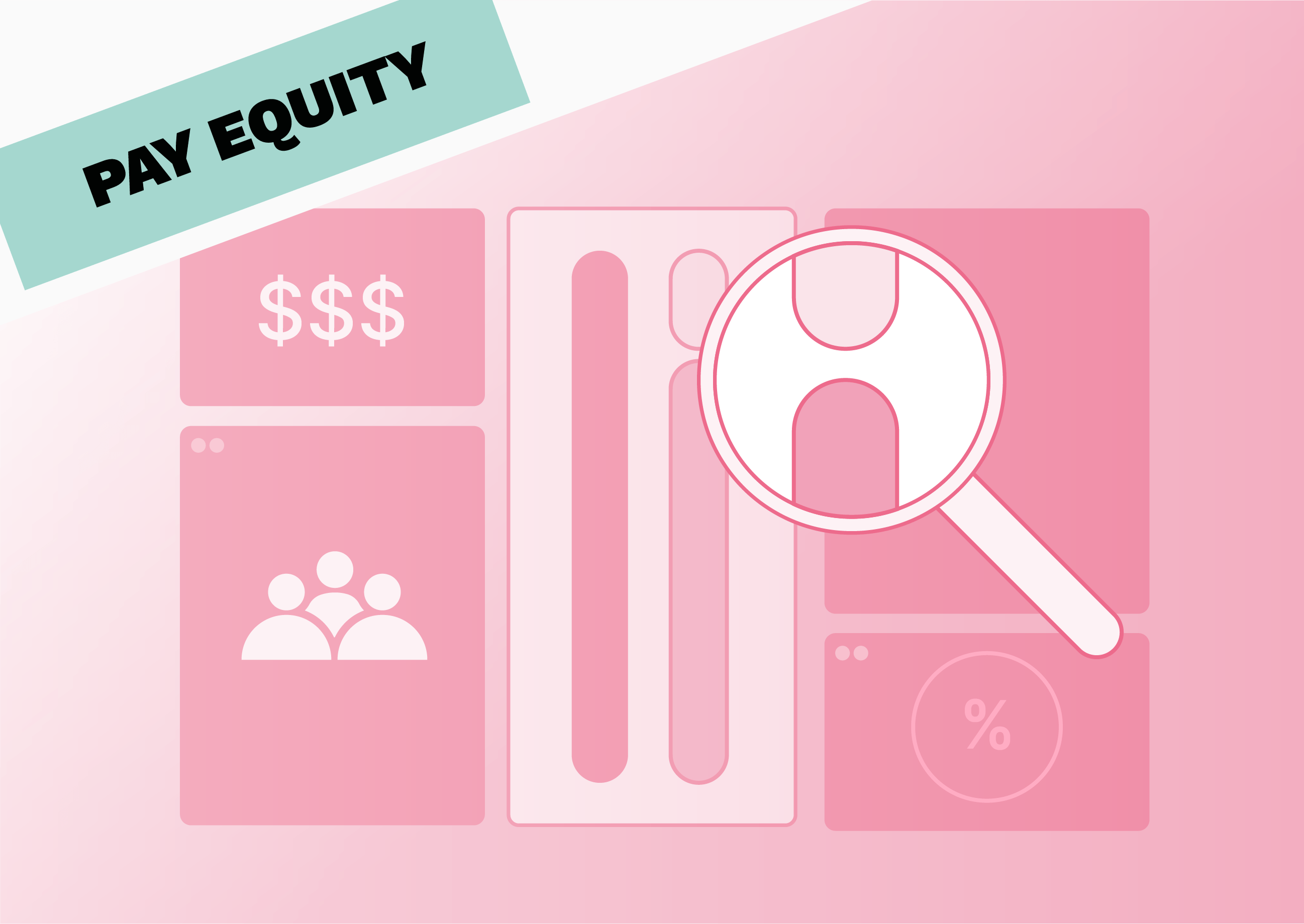The good news is, the global gender pay gap is shrinking. The bad news? At the current rate of change, it will be another 250 years before we reach full pay parity between men and women.
If you’re reading this blog, there’s a good chance you’re already committed to fair pay. Ensuring men and women are paid equally for the same work is a solid start, but the gender pay gap runs deeper.
In this article, we’ll share some concrete actions employers can take to break down the systemic, cultural and practical barriers that keep women earning less than men.
What is the gender pay gap?
The gender pay gap is the difference in average earnings between all men vs. all women within a country or an organisation. According to the latest figures, the gender pay gap across the EU is currently around 13%.
The adjusted gender pay gap is the gap that remains when you adjust for job-related factors like role, seniority and qualifications. The fact that there’s still a gap here shows there’s at least some level of bias and discrimination behind the gender pay gap.
However, the overall gender pay gap is a lot more complicated than this and is driven by multiple factors. These include:
- An uneven distribution of household and care responsibilities
- Engrained stereotypes about ‘men’s’ and ‘women’s’ work
- Biased hiring processes that favour men over women
You can’t solve all of these issues as a single employer. But there are certain things you can do to improve opportunities for female workers — and work towards closing the gender pay gap.
The basics: equal pay for equal work
Let’s get one thing straight: you can’t begin to tackle the gender pay gap if you’re not paying male and female employees equally for the same work. While this may sound obvious, there are all sorts of factors that can impact pay equity — often without you even realising it.
Here are a few actions to consider to drive pay equity within your organisation:
- Conduct regular pay equity audits to ensure equity and fairness
- Develop a structured job architecture to classify jobs consistently
- Create standardised salary bands and ensure they’re adhered to
- Ensure pay criteria are fair, objective and consistent
- Set up consistent, repeatable processes for compensation reviews
Here’s the thing, though: many companies still have a persistent gender pay gap, even though they’re doing all of the above. Keep reading to find out what to do about it.
6 ways to reduce the gender pay gap (when you’re already paying employees fairly)
As we’ve discussed, paying employees the same salary for the same work is the baseline. Until you’re doing that, there’s no point in going any further. But if you’re already doing everything you can to ensure equal pay for work of equal value? Here are some of the actions you can take to close the gender pay gap without adjusting your compensation strategy or policies.
1. Measure, measure, measure
You can’t do anything about your gender pay gap if you don’t know you have one. Even if it’s not yet required by law where you are, responsible employers should be regularly measuring and assessing the level of pay equity within their organisation.
It’s important to look at both your adjusted and non-adjusted pay gaps. If you’re truly providing equal pay for work of equal value, your adjusted pay gap should be virtually non-existent. But you may still have a non-adjusted gap, which means it’s likely that more systemic factors are at play.
You should also assess your gender pay gap in different departments and teams, as well as by hierarchical level. Basically, it’s all about gathering as much information as possible as often as you can — and then using that data to drive positive change.
2. Implement supportive policies for parents
A big driver of the gender pay gap is the fact that women still take on the lion's share of household and caregiving responsibilities. But, while this is a sad state of affairs in 2025, there’s not a lot you can do about it as an employer. What you can do is find ways to level the playing field, giving men and women equal chances of succeeding in the workplace despite their different circumstances.
For example, consider implementing policies that help women balance their home and work responsibilities, like remote work, flexible start and end times or compressed hours. Providing a childcare allowance — or even onsite childcare — can also help to relieve the burden on your female employees.
Another important factor is that women are often left behind their male counterparts when they take time out of the workforce to have children. While providing generous family leave is key, it’s also important to monitor women’s progress after returning to work after maternity or parental leave — and offer coaching or other assistance to get them back on track if needed.
3. Rethink performance reviews
Many employers take performance ratings into consideration when determining who gets a pay rise (and how much). And there’s nothing inherently unfair about this: it makes sense to reward those giving 110% for their hard work and dedication.
The problem is that performance reviews are almost always open to at least some form of bias and/or favouritism. To avoid this, you’ll need to set objective, consistent ways of measuring performance — and avoid relying on subjective manager assessments. You can read more about removing bias from performance reviews in our full guide.
4. Remove bias from hiring decisions
It’s pretty obvious that you shouldn't be taking gender into account when determining salaries for new employees. And most companies don’t do this — at least not actively. But hiring processes are often rife with bias and rely heavily on networks and referrals, which can place women at a significant disadvantage.
That means that women may not have an equal chance of making it to the offer stage — especially for higher-level roles. Here are a few things you could do to combat bias in the hiring process and give women a fighting chance of success:
- Use blind hiring techniques to remove opportunities for bias
- Set clear, consistent criteria for hiring decisions
- Limit the influence of things like culture fit and potential
- Rewrite job descriptions to remove masculine-coded language
- Don’t take past salaries into account when making offers to new employees
Want to learn more about the unfair hiring practices you should banish in the name of pay equity? Read our complete guide.
5. Improve C-suite representation
In the US, women make up just 21% of the C-Suite. And only 6% of CEOs globally are women. This is a big deal because having fewer women in leadership positions perpetuates pay gaps, and can even hinder innovation and progress. That’s not to mention the fact that women are less likely to aspire to leadership roles if they have no credible role models to look up to.
So, how can you improve gender diversity on your leadership team? The first step is to build accountability by setting time-bound, public commitments to change, and specifically seeking female candidates for open leadership positions.
However, research from McKinsey suggests that the problem starts earlier — and that women aren’t facing a glass ceiling so much as a ‘broken rung’. Developing career paths, setting up mentorship programmes and providing specific coaching and training for female employees can help them move up the ladder.
6. Increase pay transparency
Improving pay transparency within your organisation can also help to reduce the gender pay gap. However, a word of warning: while this technically doesn't mean changing your pay structures, policies or processes, it’s probably a good idea to ensure these are fair and equitable before opening them up to scrutiny.
Once you feel ready, you could consider:
- Including salary information in job ads
- Disclosing salary ranges within your organisation
- Sharing information on pay criteria with employees
- Publicly disclosing salaries or ranges (e.g. on your website)
This isn’t an all-or-nothing situation — and the right approach is different for every organisation. However, an important reminder: at least some level of pay transparency (including transparency in job descriptions) will be mandatory once the EU Pay Transparency Directive is in effect (by June 2026 at the latest). It’s a good idea to start getting ready now to ensure you’re prepared to comply.
A collective effort to close the gender pay gap
We can’t wait 250 years for full pay parity between men and women. But if we want to solve the gender pay gap sooner, we’ll need to work together.
This will require significant action from governments and regulatory bodies. An example is the EU Pay Transparency Directive, which is set to come into effect over the next few years and will represent a significant shift in the way employers handle compensation.
Individual businesses also have a role to play — even those who are already paying their employees fairly. By setting up systems and processes that empower, promote and lift up women instead of holding them back, employers can make real progress towards closing the gender pay gap.






